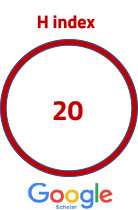| Acceptance rate | 46% |
|---|---|
| Time to first decision | 20 days* |
| Time to decision with review | 50 days* |
*Approximate number of days
**The days mentioned above are averages and do not indicate exact durations. The process may vary for each article.
ACTA Pharmaceutica Sciencia
2023 , Vol 61 , Num 4
Rapidly synthesized zinc oxide nanoparticles can increase the activity of antimicrobial drugs against clinical isolates of Pseudomonas aeruginosa and Escherichia coli
1 Reference Center for Drug Information (CRIMED), Pitágoras College, Ipatinga, MG, Brazil2 Chemistry Institute, Federal University of Uberlândia, Uberlândia, MG, Brazil
3 René Rachou Institute, FIOCRUZ Minas, Belo Horizonte, MG, Brazil
DOI : 10.23893/1307-2080.APS6127 This study aimed to investigate the effectiveness of combining zinc oxide nanoparticles (ZON) to antimicrobial drugs against clinical isolates of Pseudomonas aeruginosa and Escherichia coli. We explored two different methods to combine nitrofurantoin, cefepime, imipenem, azithromycin, gentamicin and sulfamethoxazole to ZON, using paper disks and 96 well plates. ZON was synthesized using the microwave-hydrothermal method and was characterized by UV-visible and Raman spectroscopy, X-ray diffraction, scanning electron microscopy and energy-dispersive X-ray spectroscopy. ZON cytotoxicity was tested against BGM cells, and its anti-inflammatory potential was also tested in vitro. The nanoparticles average size was of approximately 85 nm, and they decreased significantly the minimal inhibitory concentration of the tested antimicrobial drugs (ranging from 16 to more than 2000 times) when combined to them at the concentrations of 8 or 16 ?g/mL - except for azithromycin against E. coli isolates. It also lacked cytotoxicity even at 1000 ?g/mL. ZON were more effective than tenoxicam on the anti-inflammatory test. Further in vivo studies are necessary to set safe doses on living organisms. Keywords : Antimicrobial, cytotoxicity, Escherichia coli, Pseudomonas aeruginosa, zinc oxide nanoparticles





